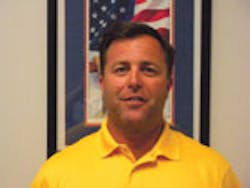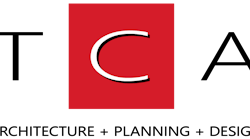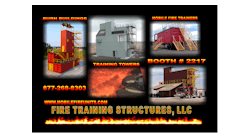Firehouse® Magazine recently asked a sampling of manufacturers of firefighter training facilities to participate in a roundtable discussion focused on issues such as ways in which their facilities help firefighters meet their training goals, after-the-sale service, funding assistance, and new technologies in materials and construction techniques. This is an excerpted version of the roundtable; the complete discussion is available at firehouse.com/0711-training-towers-roundtable.
We thank the manufacturers who joined this discussion and invite other manufacturers to participate in future discussions.
PARTICIPANTS:
RICK EGELIN, President/CEO, Fireblast 451 Inc., Corona, CA, www.fireblast.com
STEVE HAJEWSKI, Marketing Manager, Fire Facilities Inc., Sun Prairie, WI, www.firefacilities.com
BRIAN HARRIS & ERIC SCHAER, Principals, TCA Architecture & Planning, Seattle, WA, www.tca-inc.com
TOM TEMPERLY, Owner, Training Structures Group LLC (TSG), Rochester, WI, www.design-tsg.com
BILL JAHNKE, President, WHP Trainingtowers, Overland Park, KS, www.trainingtowers.com
Q. More and more demands are being placed on firefighters every day. What features do your facilities have that assist firefighters in meeting their training goals
JAHNKE: WHP’s training towers are designed to create the most realistic environments for today’s emergency personnel. WHP has a rich history in leadership within the fire service. We understand the training requirements, hazards and the need for a design proven to facilitate live-fire training under controlled conditions. We are continually refining and designing new features to challenge the trainee and the veteran fire fighter alike. We have introduced a Reconfigurable Maze System, which is usable in any building or location. We have developed a complete interactive hazmat training system which includes sound, high pressure air and water, color, scent, fog and hardware that duplicates working systems. While we offer all of the usual burn rooms, forcible entry props, rappelling systems and search & rescue props, it is equally important to train for less common, but other potentially lethal scenarios like major chemical spills or homeland security threats. We specialize in designing custom props to match the scenarios found in your community.
TEMPERLY: At Training Structures Group (TSG) we’ve seen a growing demand for multiple live-fire burn rooms within a structure. which can provide both flexibility in the training scenarios and an increase in realism of the mission. We have also seen an increase need in the number of facilities for a burn room for class “A” fire and another for class “B”. We can add either class “A” or “B” burn rooms to an existing facility or design them into a new facility to accommodate this need.
Over the years. our firefighters have been called on to respond to an ever increasing array of emergency situations. It’s no longer enough to only train for live fire scenarios. The public’s expectations are that when an emergency situation arises their firefighters will be prepared to handle it safely and expeditiously.
The tragedy of 9/11 has taught us the importance of collapse structure rescue. We learned a lot of very important lessons that day and in the days following. These lessons are being played out in other disasters such as the devastation caused by the tornados and floods that have occurred recently. Now we can provide features in our training facilities to teach and practice these techniques in a controlled, safe environment. Through proper training we can prepare our firefighters faster and safer methods of accomplishing the tasks.
HARRIS & SCHAER: Incorporating training into the actual fire station facilities is only limited by one’s imagination, from simple second-floor hatches to complex- multi functional, multi-jurisdictional training structures. The best lesson we have learned over the many years is listening to the firefighters themselves. We work very closely with the users to get the training props so they simulate real-life scenarios wherever possible.
Towers can easily be designed to emulate an office tower, residence, warehouse etc. giving the rescuers and their departments a more diverse experience. We have incorporated multi-story multi-scenario training towers that mimic the firefighter’s likely building type they will have to respond to. One side might be residential, the other industrial, the next an outdoor stair tower and the next used for high angle rescue, smoke training or movable partitions and confined space rescue. Through adjustable structural systems, floors can be removed to redefine a flat into an atrium or garden apartment. We have even converted mock crawl spaces into the hull of a ship and incorporated river rescue capabilities and simulated collapsed building walls and bridges within the fire station campus.
We are also seeing the integration of more urban search and rescue props, site rehabilitation areas, outdoor “dirty” classrooms, and shared use facilities such as water utility props, drainage systems, vaults and spill props. These can all be used by other agencies as well for occupational training.
What’s paramount is to understand your local and regional hazards and find creative ways to emulate these conditions into the props. Does a community have bridges? Perhaps consider if there could be one integrated into your facility. If so, can you use it for shoring, load transfers, lowering, creating mock catastrophic failures. Can mock utilities be installed under the bridge, can the bridge be used by other agencies. Working with other agencies is an ideal way to understand their operational risks as well. The possibilities are only limited by ones imagination of real-life training scenarios.
HAJEWSKI: Fire Facilities structures are available with a number of custom and standard features to create a safe, yet realistic training experience. Starting with approaching the structure, the unique siding profile is similar to what firefighters will encounter on actual calls, yet strong enough to allow for ladder placement or rappelling anywhere against the building. Parapet walls and window openings are designed with no exposed fasteners or sharp edges to prevent damage to gear and equipment. Inside the structure, a patented moveable wall system helps training officers to change room layouts and door location to create variety in exercises. Fire Facilities’ Westec burn rooms are built with a patented two-part insulation system, consisting of the insulation blanket and a stainless-steel liner – this system reduces maintenance costs and extends the life of the tower.
EGELIN: Fireblast 451 has a variety of fire training props and equipment representing the most challenging scenarios that firefighters face in emergency response. All Fireblast training equipment is designed utilizing the most current codes, standards and guidelines for the selected equipment. We offer an extensive line of fixed and portable training units, including Class A, Class B, special operation, and interior and exterior fixed facility props.
Portable units include flammable liquid and gas, interior live fire, industrial, helicopters and vehicle fire training. Each prop provides unique skill sets found only in Fireblast products. Portable Class A and B interior units include optional multi-chassis structures with rappelling towers, confined space, forcible entry, confidence maze, wall breech scenarios, Denver and Columbus Rescue props and firefighter self rescue training .
Special operation trainers include urban search and rescue, forcible entry, confidence maze, confined space, ventilation, arson and hazardous material trainers. Each prop offers an extensive training scenario format to challenge the most seasoned professional.
Q. Long-term care and maintenance are critical when purchasing a facility of this type. What is your company’s focus on after-the-sale service to end users?
EGELIN: Fireblast team members realize that the value of customer service extends far past the warranty period. We understand that the strength of our future depends on customer satisfaction. Post-purchase support begins with the FireCare program. FireCare provides end users with a direct link to our customer service coordinator (CSC), who will assist in all post purchase needs and be the connection to our technical support representatives (TSR). Each TSR is factory trained to provide prompt and efficient support and respond to customer demands. FireCare offers remote access and diagnostics via internet or wireless control which extend far past typical customer service. FireCare provides Fireblast TSR’s the ability to upload system functions and download program upgrades.
HAJEWSKI: After the initial sale, Fire Facilities can also provide most inspection services to meet NFPA (National Fire Protection Association) requirements. The inspections are performed by our own in-house professional engineers. In the event that a building is inadvertently damaged or components reach the end of their useful life, replacement parts are available. We also offer relining of existing burn rooms, and offer field construction services. Our buildings last a long time, so we understand the importance of being able to recreate a component from a 20-plus-year-old project.
HARRIS & SCHAER: TCA specializes in fire service architecture so we continue to learn from our clients on how materials hold up to long- and short-term use. We walk the stations with the clients after one year of occupancy to identify any material maintenance issues and document comments from the actual users of the facility to get valuable feedback on how the station works for them. These lessons are used the next time we design a project so that future client gets the benefit of all the information from all the previous stations. Beyond this one year, we continue to monitor material use and maintenance issues from materials to mechanical systems to insure we have the most current feedback. As a team, we can also walk our clients through other older facilities to see what has worked and not worked for those facilities and what maintenance issues they may be having.
TEMPERLY: At TSG we are very concerned with the longevity and maintenance requirements of our structures and provide each element with that in mind. Certain components such as the exterior skins are manufactured from base steel that is galvanized, then factory coated with two coats of baked-on enamel. Other components such as burn room doors and shutters are powder coated for durability still other components are furnished in stainless steel for both durability and corrosion resistance. Our burn room insulation system combines the time-tested calcium silicate insulation products with new technologies to greatly improve its performance and durability.
The extreme uses that these facilities are put through do necessitate some level of maintenance. Normally, minor repairs can be accomplished locally but we are also prepared to offer our services to do repairs and/or modifications to our towers. We can also modify or repair towers of other designs.
JAHNKE: WHP offers full turnkey support to its customers. From start to finish – and beyond. The customer has one number to call to get their questions answered or concerns addressed. Maintenance of the building is simple and straightforward. Elements of the building, unlike concrete and block structures, are readily observable and any wear is easy to identify and mediate. All major components are hot-dipped galvanized, which protects against rust. Most maintenance is minor and can be handled by local personnel. WHP offers inspection services designed to help departments extend the life of their facility. Additionally, we actively reach out to our customer base to share with them innovative ways that they can maximize the use of their facility. We work closely with our customers to help design additions, incorporate new options and maintain their existing structure.
Q. Funding is a challenge for all fire departments. Do you have staff and/or programs that help departments obtain grants and other funding lines?
HARRIS & SCHAER: TCA has programs and processes that allow us to work quickly with our clients in determining their training, facility and operational needs. Our philosophy is that these facilities are community investments and if we can help our clients get their needs established and show the community what the possibilities are in a positive way, the chances of getting money to build their project is much more likely.
While there are no more federal grants or “free” money for building fire stations or training towers, there are grants for equipment, programs and even vehicles if the client can show their need. We also know that there are many qualified experts in the field of grant writing and finance consulting that would benefit the cities and districts we serve. Just as TCA is an expert in our field of fire service and training facility design, we feel using experts in the fields of finance and grant writing have proven to be the most successful for our clients.
JAHNKE: WHP’s representatives bring a wealth of knowledge (gained from over 600 projects) about creative ways departments can fund training structures. Whether its grants, lease purchase, collaboration with local educational facilities, collaboration with industry, funding through municipal bonds, etc., WHP can help guide departments through their options. Additionally, we can help departments articulate the justification for a training building in their community
EGELIN: At Fireblast we know finding and receiving grants can be overwhelming. That’s why our marketing team is dedicated to researching new grant opportunities and passing these resources onto our potential customers. The Fireblast team can assist in devising a funding solution package to meet your unique training needs. Fireblast customers have been extremely successful in being awarded local and federal grants to purchase training equipment.
HAJEWSKI: We have teamed up with a third party to research and assist with the grantwriting process. Available grants are constantly changing and evolving, so this partnership is a great resource for customers to educate themselves on what’s out there. Additionally, Fire Facilities’ has a leasing program that can help provide departments with financing for their training structure or mobile unit.
TEMPERLY: At TSG we can provide assistance to fire departments with the grant writing process as well as providing plans, specifications and pricing for a facility design to meet any of the grants requirements. These grant opportunities change from year to year and from state to state but we are prepared to lend all of the assistance needed for a department to make a proper application.
Further assistance is offered by providing facilities that are specifically designed to be built in phases. We will take the final layout for the completed project and design it so that it can be constructed in as many as four phases where each individual phase provides a usable training platform. This enables the departments to budget construction as money is available. It also provides the ability for the department to qualify for grants that only apply to expanding existing facilities.









